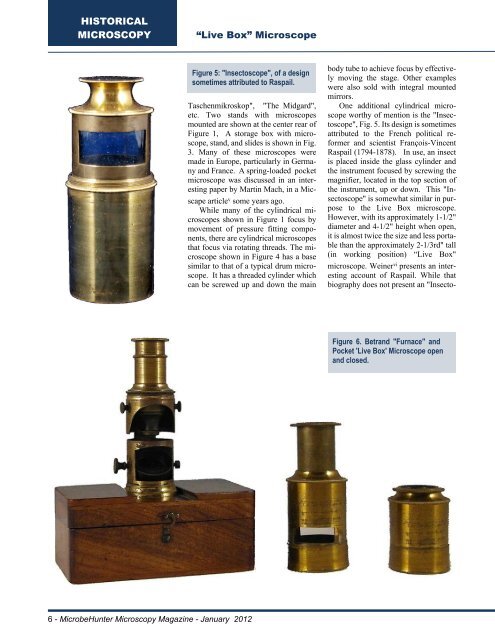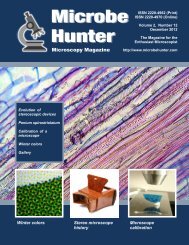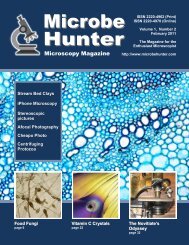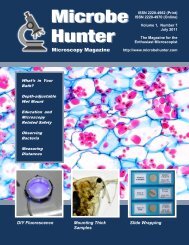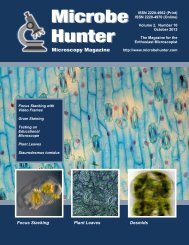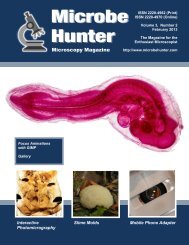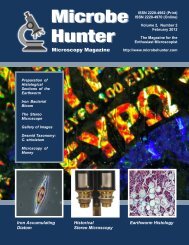Microbe Hunter Microbe Hunter - MicrobeHunter.com
Microbe Hunter Microbe Hunter - MicrobeHunter.com
Microbe Hunter Microbe Hunter - MicrobeHunter.com
You also want an ePaper? Increase the reach of your titles
YUMPU automatically turns print PDFs into web optimized ePapers that Google loves.
HISTORICAL<br />
MICROSCOPY<br />
“Live Box” Microscope<br />
Figure 5: "Insectoscope", of a design<br />
sometimes attributed to Raspail.<br />
Taschenmikroskop", "The Midgard",<br />
etc. Two stands with microscopes<br />
mounted are shown at the center rear of<br />
Figure 1, A storage box with microscope,<br />
stand, and slides is shown in Fig.<br />
3. Many of these microscopes were<br />
made in Europe, particularly in Germany<br />
and France. A spring-loaded pocket<br />
microscope was discussed in an interesting<br />
paper by Martin Mach, in a Micscape<br />
article v some years ago.<br />
While many of the cylindrical microscopes<br />
shown in Figure 1 focus by<br />
movement of pressure fitting <strong>com</strong>ponents,<br />
there are cylindrical microscopes<br />
that focus via rotating threads. The microscope<br />
shown in Figure 4 has a base<br />
similar to that of a typical drum microscope.<br />
It has a threaded cylinder which<br />
can be screwed up and down the main<br />
body tube to achieve focus by effectively<br />
moving the stage. Other examples<br />
were also sold with integral mounted<br />
mirrors.<br />
One additional cylindrical microscope<br />
worthy of mention is the "Insectoscope",<br />
Fig. 5. Its design is sometimes<br />
attributed to the French political reformer<br />
and scientist François-Vincent<br />
Raspail (1794-1878). In use, an insect<br />
is placed inside the glass cylinder and<br />
the instrument focused by screwing the<br />
magnifier, located in the top section of<br />
the instrument, up or down. This "Insectoscope"<br />
is somewhat similar in purpose<br />
to the Live Box microscope.<br />
However, with its approximately 1-1/2"<br />
diameter and 4-1/2" height when open,<br />
it is almost twice the size and less portable<br />
than the approximately 2-1/3rd" tall<br />
(in working position) “Live Box"<br />
microscope. Weiner vi presents an interesting<br />
account of Raspail. While that<br />
biography does not present an "Insecto-<br />
Figure 6. Betrand "Furnace" and<br />
Pocket 'Live Box' Microscope open<br />
and closed.<br />
6 - <strong>Microbe</strong><strong>Hunter</strong> Microscopy Magazine - January 2012


